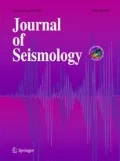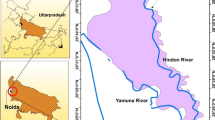Abstract
Aftershock hazard maps contain the essential information for search and rescue process, and re-occupation after a main-shock. Accordingly, the main purposes of this article are to study the aftershock decay parameters and to estimate the expected high-frequency ground motions (i.e., Peak Ground Acceleration (PGA)) for recent large earthquakes in the Iranian plateau. For this aim, the Ahar-Varzaghan doublet earthquake (August 11, 2012; M N =6.5, M N =6.3), and the Ilam (Murmuri) earthquake (August 18, 2014 ; M N =6.2) have been selected. The earthquake catalogue has been collected based on the Gardner and Knopoff (Bull Seismol Soc Am 64(5), 1363-1367, 1974) temporal and spatial windowing technique. The magnitude of completeness and the seismicity parameters (a, b) and the modified Omori law parameters (P, K, C) have been determined for these two earthquakes in the 14, 30, and 60 days after the mainshocks. Also, the temporal changes of parameters (a, b, P, K, C) have been studied. The aftershock hazard maps for the probability of exceedance (33%) have been computed in the time periods of 14, 30, and 60 days after the Ahar-Varzaghan and Ilam (Murmuri) earthquakes. For calculating the expected PGA of aftershocks, the regional and global ground motion prediction equations have been utilized. Amplification factor based on the site classes has also been implied in the calculation of PGA. These aftershock hazard maps show an agreement between the PGAs of large aftershocks and the forecasted PGAs. Also, the significant role of b parameter in the Ilam (Murmuri) probabilistic aftershock hazard maps has been investigated.



Similar content being viewed by others
References
Abrahamson, N. A., and Silva, W. J., 2008. Summary of the Abrahamson & Silva NGA ground motion relations, Earthq Spectra 24:67–97
Aki K (1965) Maximum likelihood estimate of b in the formula logN= a-bM and its confidence limits. Bull Earthq Res Inst Tokyo Univ 43:237-239
Akkar S, Bommer JJ (2010) Empirical equations for the prediction of PGA, PGV, and spectral accelerations in Europe, the Mediterranean region, and the Middle East. Seismol Res Lett 81(2):195–206
Albarello D, D'Amico V (2008) Testing probabilistic seismic hazard estimates by comparison with observations: an example in Italy. Geophys J Int 175(3):1088–1094
Boore DM, Atkinson GM (2008) Ground-motion prediction equations for the average horizontal component of PGA, PGV, and 5%-damped PSA at spectral periods between 0.01 s and 10.0 s. Earthquake Spectra 24(1):99–138
Borcherdt RD (1994) Estimates of site-dependent response spectra for design (methodology and justification). Earthquake Spectra 10(4):617–653
Campbell KW, Bozorgnia Y (2008) NGA ground motion model for the geometric mean horizontal component of PGA, PGV, PGD and 5% damped linear elastic response spectra for periods ranging from 0.01 to 10 s. Earthquake Spectra 24(1):139–171
Chiou B-J, Youngs RR (2008) An NGA model for the average horizontal component of peak ground motion and response spectra. Earthquake Spectra 24(1):173–215
Cornell CA (1968) Engineering seismic risk analysis. Bull Seismol Soc Am 58(5):1583–1606
Davis SD, Frohlich C (1991) Single-link cluster analysis of earthquake aftershocks: decay laws and regional variations. J Geophys Res Solid Earth 96(B4):6335–6350
Dieterich J (1994) A constitutive law for rate of earthquake production and its application to earthquake clustering. J Geophys Res Solid Earth 99(B2):2601–2618
Gallovič F, Brokešová J (2008) Probabilistic aftershock hazard assessment I: numerical testing of methodological features. J Seismol 12(1):53–64
Gardner J, Knopoff L (1974) Is the sequence of earthquakes in southern California, with aftershocks removed, Poissonian? Bull Seismol Soc Am 64(5):1363–1367
Gasperini P, Lolli B (2006) Correlation between the parameters of the aftershock rate equation: implications for the forecasting of future sequences. Phys Earth Planet Inter 156(1):41–58
Gerstenberger M (2003) Earthquake clustering and time-dependent probabilistic hazard analysis for California. (Ph. D. thesis)
Ghasemi H, Zare M, Fukushima Y, Koketsu K (2009) An empirical spectral ground-motion model for Iran. J Seismol 13(4):499–515
Gutenberg B, Richter CF (1944) Frequency of earthquakes in California. Bull Seismol Soc Am 34(4):185–188
Hessami K, Jamali F (2006) Explanatory notes to the map of major active faults of Iran. J Seismol Earthq Eng 8
Hough S, Jones L (1997) Aftershocks: are they earthquakes or afterthoughts? EOS Trans Am Geophys Union 78(45):505–508
Kisslinger C, Jones LM (1991) Properties of aftershock sequences in southern California. J Geophys Res Solid Earth 96(B7):11947–11958
Lolli B, Gasperini P (2003) Aftershocks hazard in Italy part I: estimation of time-magnitude distribution model parameters and computation of probabilities of occurrence. J Seismol 7(2):235–257
McGuire JJ, Boettcher MS, Jordan TH (2005) Foreshock sequences and short-term earthquake predictability on East Pacific Rise transform faults. Nature 434(7032):457–461
Mirzaei N, Mengtan G, Yuntai C (1998) Seismic source regionalization for seismic zoning of Iran: major seismotectonic provinces. J Earthq Pred Res 7:465–495
Mogi K (1963) Some discussions on aftershocks, foreshocks and earthquake swarms: the fracture of a semi-infinite body caused by an inner stress origin and its relation to the earthquake phenomena. Bull Earthq Res Inst Univ Tokyo 41:615–658.
Mousavi M, Ansari A, Zafarani H, Azarbakht A (2012) Selection of ground motion prediction models for seismic hazard analysis in the Zagros region, Iran. J Earthq Eng 16(8):1184–1207
Narteau C, Byrdina S, Shebalin P, Schorlemmer D (2009) Common dependence on stress for the two fundamental laws of statistical seismology. Nature 462(7273):642–645
Nuttli OW (1973) Seismic wave attenuation and magnitude relations for eastern North America. J Geophys Res 78(5):876–885
Ogata Y (1983) Estimation of the parameters in the modified Omori formula for aftershock frequencies by the maximum likelihood procedure. J Phys Earth 31(2):115–124
Ogata Y (1988) Statistical models for earthquake occurrences and residual analysis for point processes. J Am Stat Assoc 83(401):9–27
Ommi S, Zafarani H (2016) Analyses of seismicity parameters of the August 11th, 2012, Ahar-Varzaghan earthquakes in north-western Iran. Scientia Iranica 23(2):449–459
Ommi S, Zafarani H & Zare M (2016a) Aftershock decay rates in the Iranian plateau. Pure Appl Geophys 173(7):2305-2324
Ommi S, Zafarani H, Smirnov VB (2016b) Bayesian estimation of the Modified Omori Law parameters for the Iranian Plateau. J Seismol 20(3):953–970
Reasenberg PA, Jones LM (1989) Earthquake hazard after a mainshock in California. Science 243(4895):1173–1176
Reasenberg PA, Jones LM (1990) California aftershock hazard forecasts. Science 247(4940):345–346
Reasenberg P, Jones L (1994) Earthquake aftershocks: update. Science 265(5176):1251–1252
Reasenberg PA, Simpson RW (1992) Response of regional seismicity to the static stress change produced by the Loma Prieta earthquake. Science 255(5052):1687–1690
Rundle JB, Holliday JR, Yoder M, Sachs MK, Donnellan A, Turcotte DL, Kellogg LH (2011) Earthquake precursors: activation or quiescence? Geophys J Int 187(1):225–236
Scherbaum F, Delavaud E, Riggelsen C (2009) Model selection in seismic hazard analysis: an information-theoretic perspective. Bull Seismol Soc Am 99(6):3234–3247
Scholz C (1968) The frequency-magnitude relation of microfracturing in rock and its relation to earthquakes. Bull Seismol Soc Am 58(1):399–415
Schorlemmer D, Wiemer S, Wyss M (2005) Variations in earthquake-size distribution across different stress regimes. Nature 437(7058):539–542
Shcherbakov R, Turcotte DL, Rundle JB (2004) A generalized Omori’s law for earthquake aftershock decay. Geophys Res Lett 31:L11613, 5 pp
Soghrat M, Khaji N, Zafarani H (2012) Simulation of strong ground motion in northern Iran using the specific barrier model. Geophys J Int 188(2):645–679
Sonley E, Atkinson GM (2005) Empirical relationship between moment magnitude and Nuttli magnitude for small-magnitude earthquakes in southeastern Canada. Seismol Res Lett 76(6):752–755
Stirling M, Gerstenberger M (2010) Ground motion-based testing of seismic hazard models in New Zealand. Bull Seismol Soc Am 100(4):1407–1414
Tsukakoshi Y, Shimazaki K (2008) Decreased b-value prior to the M 6.2 Northern Miyagi, Japan, earthquake of 26 July 2003. Earth Planets Space 60(9):915
Udias A (1999) Principles of seismology. Cambridge University Press, Cambridge
Utsu T (1961) A statistical study on the occurrence of aftershocks. Geophys Mag 30:521–605
Utsu T (1971) Aftershocks and earthquake statistics (3). J Fac Sci Ser Hokkaido Univ 7(3):379–441
Utsu T, Ogata Y, Matsu'ura RS (1995) The centenary of the Omori formula for a decay law of aftershock activity. J Phys Earth 43(1):1–33
Wiemer S (2000) Introducing probabilistic aftershock hazard mapping. Geophys Res Lett 27(20):3405–3408
Wiemer S, Wyss M (2000) Minimum magnitude of completeness in earthquake catalogs: examples from Alaska, the western United States, and Japan. Bull Seismol Soc Am 90(4):859–869
Wiemer S, Gerstenberger M, Hauksson E (2002) Properties of the aftershock sequence of the 1999 Mw 7.1 Hector Mine earthquake: implications for aftershock hazard. Bull Seismol Soc Am 92(4):1227–1240
Zafarani H, Mousavi M (2014) Applicability of different ground-motion prediction models for northern Iran. Nat Hazards 73(3):1199-1228
Zafarani H, Soghrat M (2012) Simulation of ground motion in the Zagros region of Iran using the specific barrier model and the stochastic method. Bull Seismol Soc Am 102(5):2031–2045. https://doi.org/10.1785/0120110315
Ziv A (2006) Does aftershock duration scale with mainshock size? Geophys Res Lett 33(17). https://doi.org/10.1029/2006GL027141
Acknowledgements
This study was supported by the International Institute of Earthquake Engineering and Seismology (IIEES), Project No. 9602/491: “Prediction of Aftershock Hazard in the Iranian Plateau using the Statistical Met hods.”
Author information
Authors and Affiliations
Corresponding author
Appendix
Appendix
Rights and permissions
About this article
Cite this article
Ommi, S., Zafarani, H. Probabilistic aftershock hazard analysis, two case studies in West and Northwest Iran. J Seismol 22, 137–152 (2018). https://doi.org/10.1007/s10950-017-9696-7
Received:
Accepted:
Published:
Issue Date:
DOI: https://doi.org/10.1007/s10950-017-9696-7




